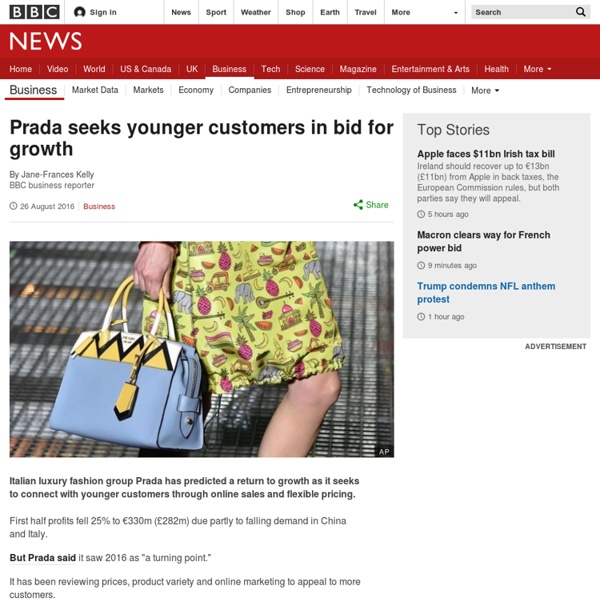3.3.4 - Starbucks drops its name and the word coffee from logo
Starbucks, the world's largest chain of coffee shops, has unveiled a new logo which it says indicates its intention to move beyond its core product. The US giant's new logo does away with the words "Starbucks" and "coffee", leaving just the firm's white on green image of a twin-tailed siren. Starbucks said that in the future "it's possible we'll have other products with our name on it and no coffee in it". However, some brand experts have criticised the move. "I think it's nuts," said James Gregory, chief executive of brand consulting firm Core Brand. "What's it going to be - the coffee formerly known as Starbucks?" Starbucks is already moving ahead with plans to extend its product range, and now also sells ice-cream. It is also considering selling beer and wine at some US outlets. Starbucks chief executive Howard Schultz said: "What is really important here is an evolutionary refinement of the logo, which is a mirror image of the strategy.
3.3.4 Train fares rise by an average of 2.3%
Image copyright PA Rail passengers are facing higher fares across the UK as average price increases of 2.3% are introduced on the first weekday of the new year. The increase covers regulated fares, including season tickets, and unregulated, such as off-peak tickets. Campaigners said the rise was a "kick in the teeth" for passengers after months of widespread strike disruption. The government said it was delivering the biggest rail modernisation programme for more than a century. The increase in fares came as a strike by conductors on Southern Rail entered its third day, as a long-running row about the role of guards on new trains continued. The RMT union began the 72-hour walkout on New Year's Eve, while another strike is set for 9 January. Why are prices rising? Image copyright Dan Kitwood By Richard Westcott, BBC transport correspondent Even if you allow for inflation, rail fares have gone up by around 25% since the mid-1990s. Some tickets have spiked by 40% in just a decade. Why? New trains
3.3.4 Dragons' Den - Entrepreneurs - Adejare Doherty
3.8.1 Boston Matrix, Culture and Dividend Yield
These two pieces of video evidence on South Korean multinational giant Samsung are pure business studies gold - particularly for students preparing their evidence for AQA BUSS4. Samsung is a highly diversified multinational that is the most significant firm in the South Korean economy. It has achieved a strong record of improved profitability, quarter after quarter, as demand for its product portfolio has grown, particularly mobile devices. However, in January 2014 it announced that it expected to suffer a fall in profits, It expects to make an operating profit of 8.3 trillion won ($7.8bn; £4.8bn) for the last quarter of 2013, down 18% from the previous three months. The two videos below explore the implications of the recent Samsung announcement. The first takes very much a business strategy perspective, using the Boston Matrix as a model of strategic choice to outline some of the issues and options for Samsung.
Coca-Cola preps Diet Coke overhaul in the UK to boost sales
Coca-Cola is overhauling its Diet Coke brand in the US and has promised “exciting” changes in the UK to fight declining sales. Diet Coke is rebranding with new packaging, flavours and a new campaign. The original Diet Coke flavour will continue, and the four new flavours include ginger lime, feisty cherry, zesty blood orange and twist mango. The launch will start mid-January in North America followed by Canada in February and a Coca-Cola spokesperson tells Marketing Week there are changes in store for the UK as well. “In the UK we also have some exciting plans for the brand this year and will be able to reveal more in the coming months.” It is currently unclear what the plans are for the UK, but a brand refresh could be timely as Nielsen data shows off-trade Diet Coke sales have dropped 0.6% over the past year to £420.2m. READ MORE: Coca-Cola Zero Sugar relaunch an early success as awareness and sales soar
Peak social media? Facebook, Twitter and Snapchat fail to make new friends | Media
Snapchat – falling into line behind Facebook and Twitter – has become the latest social network to report declining user numbers in its half year results. Snap Inc, the parent company of the app known for its disappearing messages and photograph filters, revealed that in the three months to the end of June active daily user numbers shrank from 191 million to 188 million, a 1.5% decline. It followed a controversial redesign that had prompted more than a million people to sign a petition to reverse the “annoying” changes. It has also faced intense competition from Facebook-owned Instagram. The battle to keep the attention of the social media set, and especially younger users, has been getting tougher. Kylie Jenner (@KylieJenner)sooo does anyone else not open Snapchat anymore? “Kids are fickle and Snapchat definitely seems to be falling out of favour with young people, who are its biggest fans,” says Joseph Evans, a digital media analyst at Enders.



